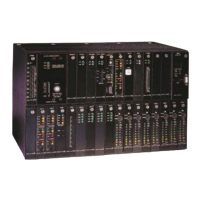Chapter 5. Diagnostics
161
Chapter 5. DIAGNOSTICS
D/I Mux III system diagnostics include alarms, power-up sequences, test loopbacks, and individual circuit
testing. The T1 alarms are the standard T1 Bell System alarms; local, remote, and Carrier Group Alarm
(CGA).
Optioned with a Dual CSU Interface, the D/I Mux III can initiate a T1 bypass, T1 CSU loopback, and also
respond to the network's T1 CSU loopback request.
To test the circuits of individual line cards, refer to the respective line card user manuals.
Software and hardware comprise the two types of diagnostics. Since the D/I Mux III is primarily a
software-configurable device, software diagnostics should be the first approach to troubleshooting the
system and network. However, an understanding of the various alarms, modes of operation, Dual DSX-1
Interfaces, and loopback capabilities is essential before any diagnostics can be performed.
Diagnostic capabilities change depending upon the type of T1 interface installed in the D/I Mux III. The
basic and Dual Enhanced DSX-1 Interface units are primarily hardware devices which allow T1 testing
with cables and loopback connectors. The Dual CSU Interface unit, with integrated Channel Service Unit
(CSU) capabilities, is required to perform T1 software diagnostics.
Test Records
Keeping an accurate record of test results is important. Records of prior performance can be very
helpful in troubleshooting. Also, the historical test data can be used to evaluate long-term system
performance.

